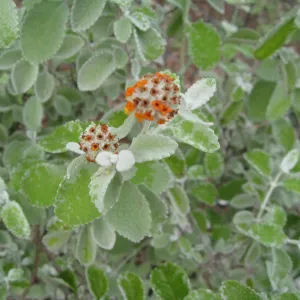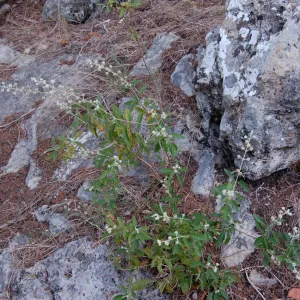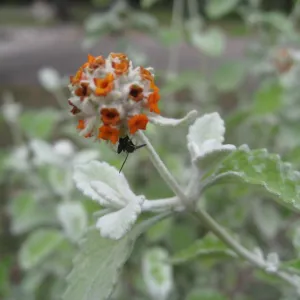by Delmar Cain – Boerne Chapter, Native Plant Society of Texas
Published in the Boerne Star on April 11, 2014
By now I am sure that you have successfully found the right spot for and planted all of those native plants that you bought at the Mostly Native Plant Sale. If we don’t get rain soon, you could have a challenge getting those plants established so that they will withstand future dry conditions. But try to think on the bright side. We keep the growers in business partly with out failures.
I have definitely contributed my share of failures for the good of their cause. A good example is my experience with the NICE (Natives Instead of Common Exotics) Plant of the Month for April recommended by the Boerne Chapter of the Native Plant Society of Texas (NPSOT). This month’s featured plant is the Woolly Butterflybush (Buddleja marrubiifolia), a native to the limestone slopes of the desert mountains of the Big Bend and northern Mexico.

I don’t remember when I first saw this plant, but I think it is when we lived in Austin. I do know that I have wanted to grow one for many years. Anne Adams’ photographs show you why. The ashy green color of its small oval leaves reminds me of Cenizo, but with a nice velvety texture. The orange to yellow marble-sized flowers at the tips of the branches to me are exotic, like something from another planet. It just seems like a friendly plant that is ready for all the sun of a hot Texas summer.
A healthy Woolly Butterflybush in a favorable spot will grow to be 3-6 feet in height. Its branches are brittle and covered with woolly hairs. It is a perennial and deciduous, but may keep some of its leaves in a mild winter. In a harsh winter it needs freeze protection during temperature drops below 15 degrees Fahrenheit. Its bloom period is from early summer into the fall and it does attract butterflies. Check the Boerne NPSOT website for planting instructions.

According to Wikipedia, the scientific name for the Buddleja tribe of plants, commonly called Butterfly-bush, is the result of a spelling mistake by Carl Linnaeus, the Swedish botanist who is considered the father of taxonomy. The group of plants was named after an English clergyman and botanist, Reverend Adam Buddle. Although the Latin spelling of Buddle should be “Buddleia”, Linnaeus spelled it “Buddleja”. It is still correctly spelled that way. However it is not unusual to see it spelled Buddleia.
Many of the Buddleja species are from Asia and Africa. But Texas has at least four species of Buddleja with one, Wand or Texas Butterflybush (Buddleja racemosa ssp. racemosa), endemic along springs and creeks in the Hill Country. Endemic means that it grows natively here and no place else in the world. It’s another rare beauty in this special place.

I was trying to add to that beauty, at least at our house, when I bought my first Woolly Butterflybush. I pick what I thought was a choice site that had a half-day of sun and good drainage. Soon after I planted it the deer browsed it. It was also one of those years in the Hill Country when it rained and rained, even when the forecast predicted only a ten percent chance. Obviously the good drainage was not good enough, because the plant died after only two strikes and didn’t wait for a third.
A couple of years later after admiring the Woolly Butterflybush at the Cibolo Nature Center, I decided that it was time for me to give the plant another try. I had an area in the courtyard that every plant loved. It had crushed granite, good drainage and good morning sun. Every seed that I tossed there germinated and flourished. So I carefully planted another Woolly Butterflybush right in the center as a future showpiece.
Then it began to rain again and the crushed granite and the caliche beneath it stayed wet for three months. An agarita volunteered at the very spot where the second Woolly Butterflybush died.
It has been about 4 years since the last plant died and, like losing a lawsuit, the pain has subsided. This year I bought another Woolly Butterflybush. I have found another spot with good drainage and adequate sun. In this spot the plant is protected from the deer. I am keeping an eye on it to make sure that it is getting enough moisture in these dry conditions. I am still hoping for rain, but I don’t want to have to build an ark. Just be forewarned that if it starts to rain, I have planted another Wooly Butterflybush. I just have this feeling that the growers must be smiling.


